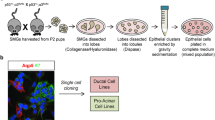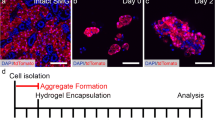Summary
The objective of these studies was to develop serum-free culture conditions for dissociated acini from rat submandibular glands. Acini were isolated from the submandibular glands of 42–46 d old rats and cultured on reconstituted rat tail collagen containing laminin in 1:1 Ham’s F12 and Dulbecco’s media, supplemented with BSA, transferrin, insulin, T3, EGF, dexamethasone, retinoic acid, carbamylcholine, and trace elements, and gassed with 50% O2. The acini became partly embedded in the collagen gel and rapidly enlarged throughout the first 22 d of culture, maintaining modest seromucous acinar differentiation, as judged morphologically and by mucin secretion. Parallel cultures then were grown under 20, 35, 50, and 65% O2, and evaluated morphologically and by DNA content. Growth and retention of seromucous acinar characteristics were best with 35% O2, but lipid accumulation and cell death were unacceptably high. A spectrum of concentrations of insulin and glucagon then were tried. With 0.05µg/ml insulin, cellular growth and organization were orderly, lipid accumulations were not excessive, and moderate differentiation was retained through 15 d of culture. With more than 0.1µg/ml insulin added to or subtracted from the optimum, the detrimental effects recurred. Addition of sufficient glucagon counteracted the effects of both optimum and excessive concentrations of insulin. We now have achieved an orderly growth of moderately differentiated rat submandibular acini for 15 d in serum-free primary culture.
Similar content being viewed by others
References
Arias, A. E.; Bendayan, M. Secretagogue induction of cell differentiation in pancreatic acinar cells in vitro. Exp. Cell Res. 195:199–206; 1991.
Ball, W. D.; Redman, R. S. Two independently regulated secretory systems within the acini of the submandibular gland of the perinatal rat. Eur. J. Cell Biol. 33:112–122; 1984.
Barer, R.; Om’iniabohs, F. Structural changes in the parotid gland induced by lipid diets. J. Physiol. (London) 248:30P-32P; 1975.
Barka, T.; Yagil, C.; van der Noen, H., et al. Induction of the synthesis of a specific protein in rat submandibular gland by isoproterenol. Lab. Invest. 54:165–171; 1986.
Bhathena, S. J.; Smith, S. S.; Voyles, N. R., et al. Studies on submaxillary gland immunoreactive glucagon. Biochem. Biophys. Res. Commun. 74:1574–1581; 1977.
Bogart, B. I.; Picarelli, J. Agonist-induced secretions and potassium release from rat submandibular gland slices. Am. J. Physiol. 235:C256-C268; 1978.
Brannon, P. M.; Hirschi, K.; Korc, M. Effects of epidermal growth factor, insulin and insulin-like growth factor I on rat pancreatic acinar cells cultured in serum-free medium. Pancreas 3:41–48; 1988.
Brannon, P. M.; Orrison, B. M.; Kretchmer, N. Primary cultures of rat pancreatic acinar cells in serum-free medium. In Vitro Cell. Dev. Biol. 21:6–14; 1985.
Cutler, L. S.; Chaudhry, A. P. Cytodifferentiation of the acinar cells of the rat submandibular gland. Dev. Biol. 41:31–41; 1974.
Durban, E. M. Mouse submandibular salivary epithelial cell growth and differentiation in long-term culture: influence of the extracellular matrix. In Vitro Cell. Dev. Biol. 26:33–43; 1990.
Fleming, N.; Teitelman, M.; Sturgess, J. M. The secretory response in dissociated acini from the rat submandibular gland. J. Morphol. 163:219–230; 1980.
Garrett, J. R.; Suleiman, A. M.; Anderson, L. C., et al. Secretory responses in granular ducts and acini of submandibular glands in vivo to parasympathetic or sympathetic nerve stimulation in rats. Cell Tissue Res. 264:117–126; 1991.
Hand, A. R.; Weiss, R. E. Effects of streptozotocin-induced diabetes on the rat parotid gland. Lab. Invest. 51:429–440; 1984.
Johnson, D. A. Changes in rat parotid salivary proteins associated with liquid diet-induced gland atrophy and isoproterenol-induced gland enlargement. Arch. Oral Biol. 29:215–221; 1984.
Justice, J. D.; Brannon, P. M. Synthesis of amylase by cultured rat pancreatic acinar cells: effects of antecedent diet. J. Nutr. 119:805–812; 1989.
Kiser, C. S.; Rahemtulla, F.; Månsson-Rahemtulla, B. Monolayer culture of rat parotid acinar cells without basement membrane substrates. In Vitro Cell. Dev. Biol. 26:878–888; 1990.
Klein, R. M. Acinar cell proliferation in the parotid and submandibular salivary glands of the neonatal rat. Cell Tissue Kinet. 15:187–195; 1982.
Korc, M.; Sankaran, H.; Wong, K. Y., et al. Insulin receptors in isolated mouse pancreatic acini. Biochem. Biophys. Res. Commun. 84:293–299; 1978.
Kumegawa, M.; Yajima, T.; Maeda, N., et al. Synergistic effects of diet, thyroxine and glucocorticoid hormones on amylase activity in parotid glands of growing rats. Arch. Oral Biol. 26:631–633; 1981.
Kurth, B. E.; Hazen-Martin, D. J.; Sens, M. A., et al. Ultrastructural and immunohistochemical characterization of submandibular duct cells in culture and modification of outgrowth differentiation by manipulation of calcium ion concentration. In Vitro Cell. Dev. Biol. 24:593–600; 1988.
Lauren, P. A.; Sorvari, T. E. The histochemical specificity of mucicarmine in the identification of epithelial mucosubstances. Acta Histochem. 34:263–272; 1969.
Lawrence, A. M.; Tan, S.; Hojvat, S., et al. Salivary gland hyperglycemic factor: an extrapancreatic source of glucagon-like material. Science 195:70–72; 1977.
Lawson, K. A. Morphogenesis and functional differentiation of the rat parotid gland in vivo and in vitro. J. Embryol. Exp. Morphol. 24:411–424; 1970.
Leeson, C. R.; Jacoby, F. An electron microscopic study of the rat submaxillary gland during its post-natal development and in the adult. J. Anat. 93:287–295; 1959.
Lefèbvre, P. J. Glucagon and adipose tissue lipolysis. In: Lefèbvre, P. J., ed. Handbook of experimental pharmacology, vol. 66/I, Glucagon I. Berlin: Springer-Verlag; 1983:419–440.
Logsdon, C. D.; Williams, J. A. Pancreatic acinar cells in monolayer culture: direct trophic effects of caerulein in vitro. Am. J. Physiol. 250:G440-G447; 1986.
Lucas, D. R. The effect of hydrocortisone, oxygen tension and other factors on the survival of the submandibular, sublingual, parotid and exorbital lacrimal glands in organ culture. Exp. Cell Res. 55:229–242; 1969.
Miederer, S. E.; Schepp, W.; Dein, H.-J., et al. Effect of glucagon on adenylate cyclase activity and acid production of isolated human parietal cells. Klin. Wochenschr. 64:746–749; 1986.
Mowry, R. W. The special value of methods that color both acidic and vicinyl hydroxyl groups in the histochemical study of mucins. With revised directions for the colloidal iron stain, the use of Alcian blue 8Gx and their combinations with the periodic acid-Schiff reaction. Ann. NY Acad. Sci. 106:402–423; 1963.
Oliver, C.; Waters, J. F.; Tolbert, C. T., et al. Growth of exocrine acinar cells on a reconstituted basement membrane gel. In Vitro Cell. Dev. Biol. 23:465–473; 1987.
Perez-Castillo, A.; Blázquez, E. Tissue distribution of glucagon, glucagon-like immunoreactivity, and insulin in the rat. Am. J. Physiol. 238:E258-E266; 1980.
Quissell, D. O. Secretory response of dispersed rat submandibular cells. I. Potassium release. Am. J. Physiol. 238:C90-C98; 1980.
Quissell, D. O.; Barzen, K. A. Secretory response of dispersed rat submandibular cells. II. Mucin secretion. Am. J. Physiol. 238:C99-C106; 1980.
Quissell, D. O.; Barzen, K. A.; Lafferty, J. L. Role of calcium and cAMP in the regulation of rat submandibular mucin secretion. Am. J. Physiol. 241:C76-C85; 1981.
Quissell, D. O.; Redman, R. S. Functional characteristics of dispersed rat submandibular cells. Proc. Natl. Acad. Sci. USA 76:2789–2793; 1979.
Quissell, D. O.; Redman, R. S.; Mark, M. R. Short-term primary culture of acinar-intercalated duct complexes from rat submandibular glands. In Vitro Cell. Dev. Biol. 22:469–480; 1986.
Qwarnström, E. E.; Hand, A. R. A granular cell at the acinar-intercalated duct junction of the rat submandibular gland. Anat. Rec. 206:181–187; 1983.
Redman, R. S. Myoepithelium of salivary glands. Microsc. Res. Tech. 27:25–45; 1994.
Redman, R. S.; Ball, W. D. Cytodifferentiation of secretory cells in the sublingual gland of the prenatal rat: a histological histochemical and ultrastructural study. Am. J. Anat. 153:367–390; 1978.
Redman, R. S.; Quissell, D. O.; Barzen, K. A. Effects of dexamethasone, epidermal growth factor, and retinoic acid on rat submandibular acinar-intercalated duct complexes in primary culture. In Vitro Cell. Dev. Biol. 24:734–742; 1988.
Redman, R. S.; Quissell, D. O. Isolation and maintenance of submandibular gland cells. In: Dobrosielski-Vergona, K., ed. Biology of the salivary glands. Boca Raton, FL: CRC Press; 1993:285–306.
Redman, R. S.; Sreebny, L. M. Proliferative behavior of differentiating cells in the developing rat parotid gland. J. Cell Biol. 46:81–87; 1970.
Reuterving, C. O.; Hägg, E.; Henriksson, R., et al. Salivary glands in long-term alloxan diabetic rats. A quantitative light and electron microscopic study. Acta Pathol. Microbiol. Immunol. Scand. A 95:131–136; 1987.
Richards, G. M. Modifications in the diphenylamine reaction giving increasing sensitivity and simplicity in the estimation of DNA. Anal. Biochem. 57:369–376; 1974.
Richardson, K. C.; Jarett, L.; Finke, E. H. Embedding in epoxy resin for ultra thin sectioning in electron microscopy. Stain Technol. 35:313–321; 1960.
Sabatini, L. M.; Allen-Hoffman, B. L.; Warner, T. F., et al. A serial cultivation of epithelial cells from human and macaque salivary glands. In Vitro Cell. Dev. Biol. 27A:939–948; 1991.
Sagulin, G. B.; Roomans, G. M. Effects of thyroxine and dexamethasone on rat submandibular glands. J. Dent. Res. 68:1247–1251; 1989.
Sarles, J.; Lee, P.-C.; Lebenthal, E. The effect of cholecystokinin-octapeptide, insulin, glucagon, triiodothyronine, and epidermal growth factor on amylase activity in fetal pancreas in vitro. Pediatr. Res. 23:539–542; 1988.
Schneyer, C. A.; Hall, H. D. Autonomic regulation of postnatal changes in cell number and size of rat parotid. Am. J. Physiol. 219:1268–1272; 1970.
Schneyer, C. A.; Hall, H. D. Autonomic regulation of changes in rat parotid amylase during postnatal development. Am. J. Physiol. 223:172–175; 1972.
Silverman, P. H.; Dunbar, J. C. The submaxillary gland as a possible source of glucagon. Bull. Sinai Hosp. Detroit 22:192–193; 1974.
Simson, J. A. V.; Dom, R. M.; Sannes, P. L., et al. Morphology and cytochemistry of acinar secretory granules in normal and isoproterenol-treated submandibular glands. J. Microsc. 113:185–203; 1978.
Smith, S.; Mazur, A.; Voyles, N., et al. Is submaxillary immunoreactive glucagon important in carbohydrate homeostasis? Metabolism 28:343–347; 1979.
Smith, P. H.; Toms, B. B. Immunocytochemical localization of insulin-and glucagon-like peptides in rat salivary glands. J. Histochem. Cytochem. 34:627–632; 1986.
Srinivasan, R.; Chang, W. W. L. Effect of neonatal sympathectomy on the postnatal differentiation of the submandibular gland of the rat. Cell Tissue Res. 180:99–109; 1977.
Tapp, R. L. An attempt to maintain cultures from the submandibular gland of the adult rat in vitro. Exp. Cell Res. 47:536–544; 1967.
Tiengo, A.; Nosadini, R. Glucagon and lipoprotein metabolism. In: Lefèbvre, P. J., ed. Handbook of experimental pharmacology, vol. 66/I, Glucagon I. Berlin: Springer-Verlag; 1983:441–451.
Wigley, C. B.; Franks, L. M. Salivary epithelial cells in primary culture: characterization of their growth and functional properties. J. Cell Sci. 20:149–165; 1976.
Yeh, C.-K.; Mertz, P. M.; Oliver, C., et al. Cellular characteristics of long-term cultured rat parotid acinar cells. In Vitro Cell. Dev. Biol. 27A:707–712; 1991.
Zajicek, C.; Yagil, C.; Michaeli, Y. The streaming submandibular gland. Anat. Rec. 213:150–158; 1985.
Author information
Authors and Affiliations
Rights and permissions
About this article
Cite this article
Quissell, D.O., Redman, R.S., Barzen, K.A. et al. Effects of oxygen, insulin, and glucagon concentrations on rat submandibular acini in serum-free primary culture. In Vitro Cell Dev Biol - Animal 30, 833–842 (1994). https://doi.org/10.1007/BF02639393
Received:
Accepted:
Issue Date:
DOI: https://doi.org/10.1007/BF02639393




